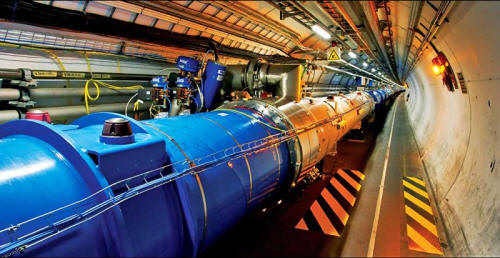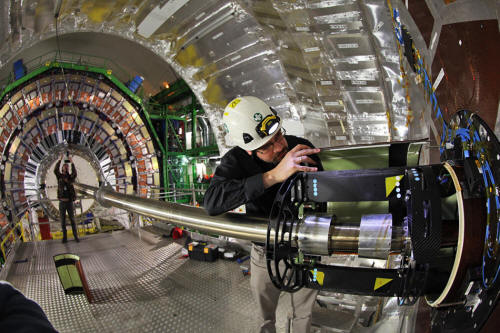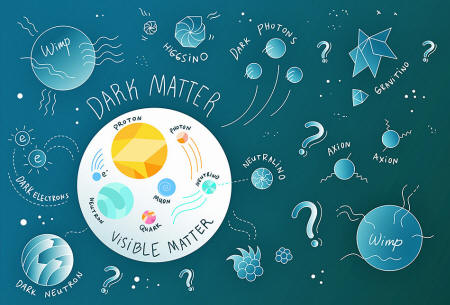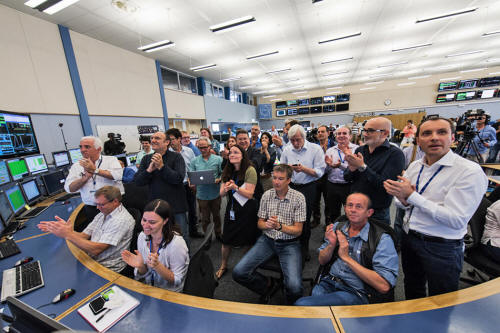|
from
Space Website
The Large Hadron Collider is the world's most powerful particle accelerator. In June 2015, the LHC was restarted at nearly twice the energy
at which it operated
during its first run, which ended in 2013.
Somewhere under the French-Swiss border, two protons have a date with destiny.
Trapped inside the Large Hadron
Collider (LHC),
the world's largest and most powerful particle accelerator, they
follow a circular path in opposite directions with velocities very
near the speed of light.
But the rules of the micro-realm are
quite different from what familiar intuition developed in the corner
pub would suggest.
(tera-electronvolts
or TeV), recorded by the CMS experiment on the LHC.
Colliding with success
After a
broad program of refurbishments,
retrofits and upgrades, the accelerator is essentially an entirely
new facility. Operating at nearly double the energy and triple the
number of collisions per second, the LHC will create collisions
within the centers of four huge experiments, each ready to make the
discovery of the century.
As described by Einstein's famous equation (E = mc2), energy can be converted into matter and vice versa. And that's one of the big things that happens inside a particle accelerator.
The huge kinetic (i.e., moving) energy
of the two incoming beam particles is converted into the mass of
particles that didn't exist before the collision.
The motion energy of the protons is
literally transformed into a very heavy particle.
A collision recorded by the CMS experiment in 2011
that was a
candidate for Higgs data.
Two large experiments, each comprised of around 3,000 scientists, were focused predominantly on finding the Higgs boson. Predicted in 1964, the Higgs boson is connected to the Higgs field, which is thought to give the mass to fundamental (i.e., pointlike) subatomic particles.
Finding the Higgs boson meant that the
idea of the Higgs field was validated.
Explaining this is simple:
But a completed puzzle is silent on what to do next.
From our observation of galaxies, we know that they rotate faster than can be explained by the known laws of gravity and the matter we can detect. To explain that mystery, we invented an unobserved form of matter called dark matter.
The fundamental nature of
dark matter is certainly a big
mystery.
During the Big Bang, the universe was full of energy, and this energy transformed into equal amounts of matter and antimatter. Yet when scientists look at the universe, they see only matter. So where did the antimatter go?
While physicists have had a few hints
from previous experiments, we don't really know the answer. This is
another mystery.
However, it is natural to ask if there might be even smaller building blocks. While scientists don't know the answer, there must be some sort of deeper and more fundamental physics that can explain the patterns seen in the quarks and leptons.
The answer to that question is yet
another mystery.
Engineers work on one of the CMS detectors
during the scheduled
two-year shutdown of the LHC.
But there is one question for which LHC
data is a surer bet.
This behavior leads to predictions of the mass of the Higgs boson that are closer to the Planck mass which is a hundred quadrillion times heavier than the mass that scientists have measured.
(The Planck mass is the highest mass our
current theories could possibly apply and marks a frontier beyond
which we are certain that we will have to rethink everything.)
Supersymmetry
This idea essentially postulates that the force-carrying bosons (particles with a subatomic spin that is integer multiple of ħ (which is the natural unit for spin in the quantum world).
For example, photons of spin 1 × ħ and the matter-carrying fermions (particles with half integer subatomic spin, e.g. electrons of spin 1/2 x ħ) should appear in the theory in a symmetric way. That means if you swap all the fermion and boson symbols, the equation will remain unchanged.
Essentially
this puts forces and matter on equal footing, making them
conceptually interchangeable.
Supersymmetry says that the familiar
quarks and
leptons must come with new, related
particles physicists now call
squarks and
sleptons. Similarly,
supersymmetric analogs of the
photon and
gluon, called photinos and
gluinos, must exist.
With supersymmetry accounting for the
other particles, the calculations result in a predicted mass of the
Higgs boson that is small, in accordance with measurements.
Scientists celebrate the first recorded collisions
at 13TeV in CERN's
LHC Control Center on June 3, 2015.
Thus, researchers are exploring other possibilities, for example, the ideas that there might exist additional dimensions of space or that the Higgs boson might contain smaller particles within it.
These ideas and others are alternative
approaches for taming the unruly predictions of the mass of the
Higgs boson.
Thus it is difficult to know exactly what discoveries will be made at the LHC.
However, it seems probable that the mystery of the mass of the Higgs boson is the most promising thread at which scientists can tug. Hopefully, the right tug will let us unravel the existing Standard Model and allow us to knit an even better theory.
Only time will tell if we will be
successful.
|







